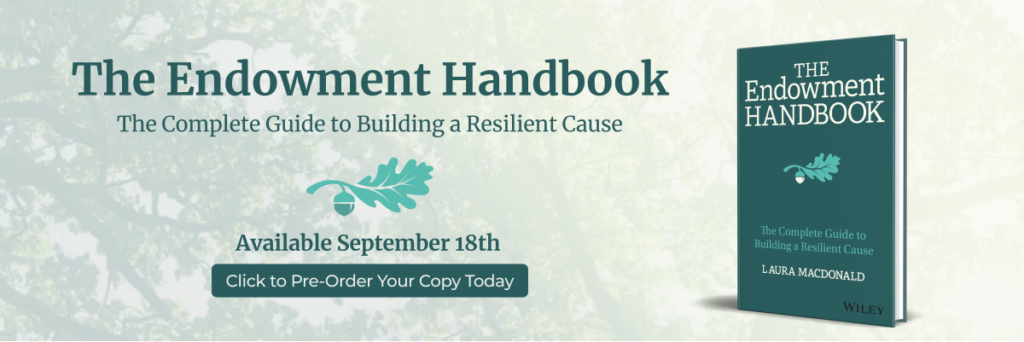Experts declare we are in the midst of the greatest transfer of wealth in history. Baby boomers and their elders are expected to hand down $84 trillion in the coming decades. If the portion bestowed to causes—an estimated $12 trillion—were endowed, the resulting annual draw would approach total giving in 2023: $540 billion!
A share of this bounty distributed equally to every cause could create endowments of $7 million, yielding an annual draw of more than $300,000 for each. But these funds won’t be distributed equally.
The funds will go to the organizations that do the hard work of preparation.
Endowments are traditionally created and increased through bequests and other planned gifts from individual donors. Here are the ways your organization can encourage donors to consider your cause when they allocate their estate.
- Get educated about endowment. Your board members, executives, and development team need to understand endowments. One place to start is The Endowment Handbook. Knowledge will allow your team to speak to donors with confidence and manage endowed funds for permanence.
- Check your policies. Has your board adopted a policy that states “every realized bequest will be allocated to the endowment?” They should. Donors will ask how your organization manages and uses endowment, and how your policies ensure growth to maintain the funds’ purchasing power. Make sure you are ready to secure and manage endowed funds with appropriate policies for acceptance, investment, and disbursement.
- Make the case. Inspire donors with a compelling rationale. Financial resilience alone won’t inspire donors to transfer funds from their investment accounts to yours. Instead, be prepared to show how a permanent endowment will perpetuate the impact they want to have in the world. (Note: the case needs to be written. Mere ideas—that might be described differently depending on who is telling the story—will not suffice.)
- Popularize bequests. Tell stories about the donors who decide to devote a portion of their estate to your cause. Tell stories about the bequests you’ve received and how the draw from the resulting endowed fund helps to fuel your mission. When donors hear about the decisions of people like them—and the resulting impact—they are more likely to follow the good example.
- Don’t forget about other assets. More and more, donors are designating their favorite causes as the beneficiary of retirement assets, life insurance, and even as the successor to a donor-advised fund. While these gifts aren’t complicated, your organization may want access to a planned giving advisor to provide guidance from time to time.
In addition to bequests, some donors elect to create endowed funds during their lifetime. Inspire gifts to endowed funds with the following actions.
- Establish affinity funds. A general endowment can be hard to love. However, a donor who cares about students may be attracted to add to scholarship funds. A couple that loves art could add to a fund for exhibitions. An entrepreneur may endow workforce development programs while gifts from an avid reader can increase the endowment for a resource center.
- Employ endowment-building tactics, such as a special day-of-giving devoted to your endowed fund, or a portion of event proceeds. Does your organization encourage giving circles? (Hint: it should.) A giving circle can be presented with opportunities to support a variety of endowed funds and select the one that appeals to its members.
The result of all this hard work will be seen in the slow and steady increase in the value of the endowment. Some nonprofit leaders take comfort in the growing strength of the balance sheet and may be tempted to treat the endowment like a “rainy-day fund,” avoiding withdrawals unless absolutely necessary. It’s a temptation that should be rejected, leading to the final factor.
- Deploy endowment funds wisely. Take an annual draw, which is generally 4.5% of the endowed funds’ total value. For example, an endowment of $1 million should yield $45,000 annually for programs and services. If the investments grow by more than 4.5% (and they should in a typical year), the remaining growth is reinvested so that annual draws keep pace with inflation. Devote the draw to specific, impactful activities rather than a simple allocation to the general operating budget (although the activities should be a part of your normal operations). This will allow you to tell inspiring stories that will attract new donors and keep the endowment growing.






